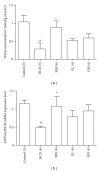Suppression of diet-induced hypercholesterolemia by turtle jelly, a traditional chinese functional food, in rats
- PMID: 23243438
- PMCID: PMC3514861
- DOI: 10.1155/2012/320304
Suppression of diet-induced hypercholesterolemia by turtle jelly, a traditional chinese functional food, in rats
Abstract
Consumption of functional foods for lowering serum cholesterol has globally gained acceptance by the general public. Turtle jelly (TJ), also called gui-ling-gao, is a popular traditional functional food in southern China. The hypocholesterolemic effect of consuming TJ was investigated in rats fed with normal diet, high-cholesterol diet or high-cholesterol diet supplemented with simvastatin (3 mg/kg bw per day, p.o.) or TJ (3.3 or 10 mL/kg bw per day, p.o.) for 30 days. TJ markedly reversed the increased serum total cholesterol, increased high-density lipoprotein, and decreased high-density lipoprotein induced by hypercholesterolemic diet with a dose-dependent improvement on the atherogenic index. It also demonstrated good hepatoprotective function by reducing fat depositions and overall lipid contents in the liver and increasing the activities of hepatic antioxidative enzymes. The blunted nitric oxide/endothelium-mediated aortic relaxation in rats fed with hypercholesterolemic diet was partially restored after TJ consumption. It is postulated that the hypocholesterolemic effect is the primary beneficial effect given by TJ; it then leads to secondary beneficial effects such as vasoprotective and hepatoprotective functions. The results revealed that TJ could block the downregulation of LDLR and PEPCK and upregulation of PPARα mRNA and protein expressions in the livers of rats fed with hypercholesterolemic diet.
Figures









References
-
- Deepa PR, Varalakshmi P. Atheroprotective effect of exogenous heparin-derivative treatment on the aortic disturbances and lipoprotein oxidation in hypercholesterolemic diet fed rats. Clinica Chimica Acta. 2005;355(1-2):119–130. - PubMed
-
- Gotto AM., Jr. Cholesterol management in theory and practice. Circulation. 1997;96(12):4424–4430. - PubMed
-
- Moncada S, Martin JF, Higgs A. Symposium on regression of atherosclerosis. European Journal of Clinical Investigation. 1993;23(7):385–398. - PubMed
-
- Kwok CY, Wong CNY, Yau MYC, et al. Consumption of dried fruit of Crataegus pinnatifida (hawthorn) suppresses high-cholesterol diet-induced hypercholesterolemia in rats. Journal of Functional Foods. 2010;2(3):179–186.
-
- Rosenson RS. Pluripotential mechanisms of cardioprotection with HMG-CoA reductase inhibitor therapy. American Journal of Cardiovascular Drugs. 2001;1(6):411–420. - PubMed
LinkOut - more resources
Full Text Sources

